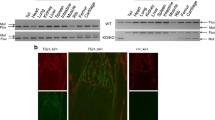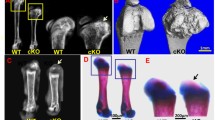Abstract
Sox9 is expressed in multiple tissues during mouse development and adulthood. Mutations in the Sox9 gene or changes in expression levels can be attributed to many congenital diseases. Heterozygous loss-of-function mutations in the human SOX9 gene cause Campomelic dysplasia, a semi-lethal skeletal malformation syndrome. Disruption of Sox9 by conventional gene targeting leads to perinatal lethality in heterozygous mice, hence hampering the feasibility to obtain the homozygous Sox9 null mice for in vivo functional studies. In this study, we generated a conditional allele of Sox9 (Sox9 tm4.Tlu) by flanking exon 1 with loxP sites. Homozygous mice for the Sox9 tm4.Tlu allele (Sox9 flox/flox) are viable, fertile and indistinguishable from wildtype (WT) mice, indicating that the Sox9 tm4.Tlu allele is a fully functional Sox9 allele. Furthermore, we demonstrated that Cre-mediated recombination using a Col2a1-Cre line resulted in specific ablation of Sox9 activity in cartilage tissues.





Similar content being viewed by others
References
Akiyama H, Chaboissier MC, Martin JF, Schedl A, de Crombrugghe B (2002) The transcription factor Sox9 has essential roles in successive steps of the chondrocyte differentiation pathway and is required for expression of Sox5 and Sox6. Genes Dev 16:2813–2828
Bi W, Deng JM, Zhang Z, Behringer RR, de Crombrugghe B (1999) Sox9 is required for cartilage formation. Nat Genet 22:85–89
Farley FW, Soriano P, Steffen LS, Dymecki SM (2000) Widespread recombinase expression using FLPeR (flipper) mice. Genesis 28:106–110
Foster JW, Dominguez-Steglich MA, Guioli S, Kwok C, Weller PA, Stevanovic M, Weissenbach J, Mansour S, Young ID, Goodfellow PN et al (1994) Campomelic dysplasia and autosomal sex reversal caused by mutations in an SRY-related gene. Nature 372:525–530
Hayashi S, McMahon AP (2002) Efficient recombination in diverse tissues by a tamoxifen-inducible form of Cre: a tool for temporally regulated gene activation/inactivation in the mouse. Dev Biol 244:305–318
Houston CS, Opitz JM, Spranger JW, Macpherson RI, Reed MH, Gilbert EF, Herrmann J, Schinzel A (1983) The campomelic syndrome: review, report of 17 cases, and follow-up on the currently 17-year-old boy first reported by Maroteaux et al. in 1971. Am J Med Genet 15:3–28
Kist R, Schrewe H, Balling R, Scherer G (2002) Conditional inactivation of Sox9: a mouse model for campomelic dysplasia. Genesis 32:121–123
Kraus P, Leong G, Tan V, Xing X, Goh JW, Yap SP, Lufkin T (2010) A more cost effective and rapid high percentage germ-line transmitting chimeric mouse generation procedure via microinjection of 2-cell, 4-cell, and 8-cell embryos with ES and iPS cells. Genesis 48:394–399
Le Y, Sauer B (2001) Conditional gene knockout using Cre recombinase. Mol Biotechnol 17:269–275
Lefebvre V, Dumitriu B, Penzo-Mendez A, Han Y, Pallavi B (2007) Control of cell fate and differentiation by Sry-related high-mobility-group box (Sox) transcription factors. Int J Biochem Cell Biol 39:2195–2214
Lufkin T, Mark M, Hart CP, Dolle P, LeMeur M, Chambon P (1992) Homeotic transformation of the occipital bones of the skull by ectopic expression of a homeobox gene. Nature 359:835–841
Mansour S, Hall CM, Pembrey ME, Young ID (1995) A clinical and genetic study of campomelic dysplasia. J Med Genet 32:415–420
Nagy A (2000) Cre recombinase: the universal reagent for genome tailoring. Genesis 26:99–109
Ng LJ, Wheatley S, Muscat GE, Conway-Campbell J, Bowles J, Wright E, Bell DM, Tam PP, Cheah KS, Koopman P (1997) SOX9 binds DNA, activates transcription, and coexpresses with type II collagen during chondrogenesis in the mouse. Dev Biol 183:108–121
Ovchinnikov DA, Deng JM, Ogunrinu G, Behringer RR (2000) Col2a1-directed expression of Cre recombinase in differentiating chondrocytes in transgenic mice. Genesis 26:145–146
Pfeifer A, Kessler T, Yang M, Baranov E, Kootstra N, Cheresh DA, Hoffman RM, Verma IM (2001) Transduction of liver cells by lentiviral vectors: analysis in living animals by fluorescence imaging. Mol Ther 3:319–322
Rodriguez CI, Buchholz F, Galloway J, Sequerra R, Kasper J, Ayala R, Stewart AF, Dymecki SM (2000) High-efficiency deleter mice show that FLPe is an alternative to Cre-loxP. Nat Genet 25:139–140
Shibata H, Toyama K, Shioya H et al (1997) Rapid colorectal adenoma formation initiated by conditional targeting of the Apc gene. Science 278:120–123
Soriano P (1999) Generalized lacZ expression with the ROSA26 Cre reporter strain. Nat Genet 21:70–71
Tribioli C, Lufkin T (1999) The murine Bapx1 homeobox gene plays a critical role in embryonic development of the axial skeleton and spleen. Development 126:5699–5711
Tribioli C, Lufkin T (2006) Bapx1 homeobox gene gain-of-function mice show preaxial polydactyly and activated Shh signaling in the developing limb. Dev Dyn 235:2483–2492
Vidal VP, Chaboissier MC, de Rooij DG, Schedl A (2001) Sox9 induces testis development in XX transgenic mice. Nat Genet 28:216–217
Wegner M (2010) All purpose Sox: the many roles of Sox proteins in gene expression. Int J Biochem Cell Biol 42:381–390
Wright E, Hargrave MR, Christiansen J, Cooper L, Kun J, Evans T, Gangadharan U, Greenfield A, Koopman P (1995) The Sry-related gene Sox9 is expressed during chondrogenesis in mouse embryos. Nat Genet 9:15–20
Acknowledgments
We thank Song Jie, Agnes Lim and Justin Tan for excellent technical assistance. This work was supported by the Agency for Science, Technology and Research (A*STAR).
Author information
Authors and Affiliations
Corresponding author
Rights and permissions
About this article
Cite this article
Yap, S.P., Xing, X., Kraus, P. et al. Generation of mice with a novel conditional null allele of the Sox9 gene. Biotechnol Lett 33, 1551–1558 (2011). https://doi.org/10.1007/s10529-011-0608-6
Received:
Accepted:
Published:
Issue Date:
DOI: https://doi.org/10.1007/s10529-011-0608-6




